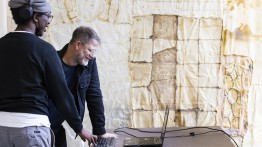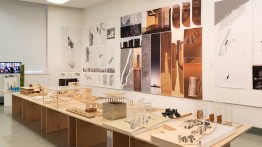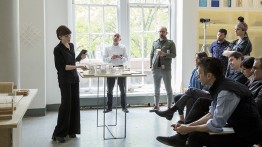Bachelor of Architecture
PROGRAM DESCRIPTION
The Bachelor of Architecture curriculum of the School of Architecture is designed to provide students with a comprehensive educational experience dedicated to gaining knowledge and skills in preparation for the successful and ethical practice of architecture. Design studios and courses build cumulatively over five years to establish a broad, deep foundation of knowledge in architecture and urban design in relation to the sciences, arts, and technology. The curriculum stresses the importance of architecture as a humanistic discipline concerned with the design and construction of habitats in diverse social and ecological conditions, and their corresponding requirements for sustainability and ethical responsibility.
The traditional and essential skills of drawing, model-making, and design development are complemented by a full investigation of the analytical and critical uses of digital technologies. The study of world architecture and urbanism is deepened by an understanding of individual cultures, as well as environmental and technological issues at every scale. Architectural theory, past and present, is investigated through close analysis of critical texts and related to the theory and practice of other arts, such as public art, film, and video. The School of Architecture, working together with the School of Art, the Albert Nerken School of Engineering, and the Faculty of Humanities and Social Sciences, offers a unique opportunity for interaction and interdisciplinary research and experience.
In recent years the school has developed its studio curriculum in ways that have reinforced its strong traditions of design and craft while investigating problems that reflect the changing conditions of contemporary practice, the urgent issues resulting from rapid urbanization, and the need for environmental and cultural conservation. In these studio experiments, students and faculty explore together the potential contributions of architecture to our changing world, redoubling their efforts to imagine a positive future for an architecture that is, after all, a discipline of design. This task does not involve a wholesale rejection of the past—as understood through our traditions and historical experience—for what has changed are not the principles, but rather the determinants and the materials of design. We are in the process of re-learning the poetics of a space of life: of air and water, of geology and geography, of culture and society, of poetics that lie deeply within these elemental forces. On this re-framing— programmatically, technologically, and above all formally—rests not simply the future of architecture, but of our life in the world. Gradually, out of this process, architecture, once more, may become a force through which life is transcribed into art in order to enhance life.
Cooper Union’s five-year professional program is framed within the context of a rigorous liberal arts education that includes a wide range of required and elective courses in the humanities and social sciences. Together with elective opportunities in the art and engineering schools, this program emphasizes the nature of architecture as a cultural, social, and technological practice intimately tied to increasingly urgent questions raised by our man-made and natural environments.
First Year
The first year is conceived as a broad introduction to society, culture, environment, and the nature, place, and role of architecture in this context. Students are introduced to the principles and experience of drawing and representation in a broad range of media and formats: freehand drawing is taught side by side with projective geometry (hand-constructed and computer-generated), and other means of architectural representation. Architectonics studios encourage the investigation of space, structure, and form—inflected by the occupation and movement of the human body—in the context of environments, from natural to urban. The first two semesters of the History of Architecture sequence take students through global developments in architecture, from Antiquity to the end of the Medieval Period, with special attention to non-western and traditional architectures. The first year of the Humanities and Social Sciences Core emphasizes reading, writing, and analytical skills through the study of literary, historical, and sociological texts.
Second Year
The second year advances student knowledge of architecture historically, culturally, and professionally. Second-year design studios examine, through analysis and design exercises, the “elements” of architecture and their assemblage, including site, ecological conditions, program, spatial accommodation, organization, structure, and environment. The first segment of the structures sequence introduces students to the principles of architectural structure. The second two semesters of the History of Architecture sequence examine the history of global architecture from the Renaissance to the present, with a special emphasis on the complex environmental relations between increasingly industrialized and developing societies. The second year of the Humanities and Social Sciences core focuses on writing and analytic skills with in-depth courses in literature, history, and philosophy.
Third Year
The third year is envisioned as a comprehensive experience of design and professional knowledge, supplemented by a range of required and elective courses in environmental, technological, and humanistic subjects. This approach forms an integrated introduction to an environmental, social, and programmatic understanding of design. Third-year design studios build from analysis to synthesis, ranging from analyses of total building assemblages and smaller-scale design exercises to the development of a comprehensive design for a complex programmatic institution. To this end, faculty teaching environmental technology, building technology, and structures join design faculty in the studio, where students elaborate on appropriate design aspects of work from their non-studio courses.
Fourth Year
The fourth year broadens the study of architecture, placing it within its diverse urban and rural contexts, as students gain advanced knowledge of technological, structural, and professional concerns, as well as the planning, zoning, social, and cultural implications of architectural interventions. Fourth-year design studios study the relationship of institutional architecture to urban networks and infrastructures, public space, and typologies. Investigations range from rebuilding strategies following disasters, and the role and nature of tall buildings, to the nature of public and private institutions. The study of landscape is emphasized, both as large-scale natural environments and smaller-scale site developments. A broad spectrum of specialized elective courses—including Modern Architectural Concepts; Analysis of Architectural Texts; Landscape Architecture; Advanced Topics in Environmental Studies; History, Theory and Criticism; and Advanced Concepts in related arts and professional ethics—deepens understanding of the profession and its relationship to different cultures and environmental contexts.
Fifth Year
The fifth year is constructed around the student’s development of an individual thesis project, and the in-depth study of professional practice in all its aspects. The year-long thesis is divided into two stages, each a semester long, with intensive research followed by a comprehensive design project. Thesis subjects vary in scale and context, with the proviso that the student investigates a problem of fundamental importance to contemporary life and architecture, identified as a site for the intervention of design as an ameliorative construct. Overall, the design thesis emphasizes the profound relationship of architecture to the broader problems of the environment and ecological sustainability, from the scale of desertification and rising sea-waters brought on by global warming, and the provision of unpolluted water to developing communities, to the smaller scales of urban signification, mobility, and programmatic reuse. A fifth-year course in professional practice surveys questions of licensing, internship, and IDP participation, and introduces students, through site visits, to a range of practices and public hearings.









